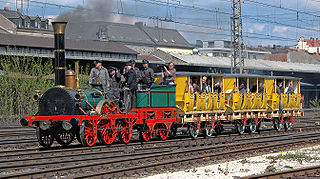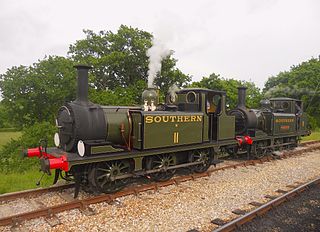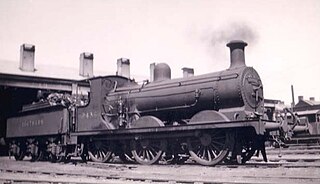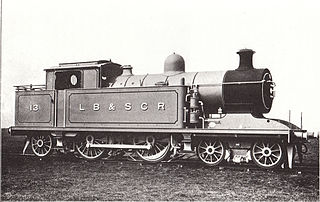
The London, Brighton and South Coast Railway was a railway company in the United Kingdom from 1846 to 1922. Its territory formed a rough triangle, with London at its apex, practically the whole coastline of Sussex as its base, and a large part of Surrey. It was bounded on its western side by the London and South Western Railway (L&SWR), which provided an alternative route to Portsmouth. On its eastern side the LB&SCR was bounded by the South Eastern Railway (SER)—later one component of the South Eastern and Chatham Railway (SE&CR)—which provided an alternative route to Bexhill, St Leonards-on-Sea, and Hastings. The LB&SCR had the most direct routes from London to the south coast seaside resorts of Brighton, Eastbourne, Worthing, Littlehampton and Bognor Regis, and to the ports of Newhaven and Shoreham-by-Sea. It served the inland towns and cities of Chichester, Horsham, East Grinstead and Lewes, and jointly served Croydon, Tunbridge Wells, Dorking and Guildford. At the London end was a complicated suburban and outer-suburban network of lines emanating from London Bridge and Victoria, and shared interests in two cross-London lines.

Under the Whyte notation for the classification of steam locomotives, 2-2-2 represents the wheel arrangement of two leading wheels on one axle, two powered driving wheels on one axle, and two trailing wheels on one axle. The wheel arrangement both provided more stability and enabled a larger firebox than the earlier 0-2-2 and 2-2-0 types. This configuration was introduced in 1834 on Robert Stephenson's 'Patentee locomotive' but it was later popularly named Jenny Lind, after the Jenny Lind locomotive which in turn was named after the popular singer. They were also sometimes described as Singles, although this name could be used to describe any kind of locomotive with a single pair of driving wheels.

Under the Whyte notation for the classification of steam locomotives, 0-4-2 represents the wheel arrangement with no leading wheels, four powered and coupled driving wheels on two axles and two trailing wheels on one axle. While the first locomotives of this wheel arrangement were tender engines, the configuration was later often used for tank engines, which is noted by adding letter suffixes to the configuration, such as 0-4-2T for a conventional side-tank locomotive, 0-4-2ST for a saddle-tank locomotive, 0-4-2WT for a well-tank locomotive and 0-4-2RT for a rack-equipped tank locomotive. The arrangement is sometimes known as Olomana after a Hawaiian 0-4-2 locomotive of 1883.

The London, Brighton and South Coast Railway (LB&SCR) A1 Class is a class of British 0-6-0T steam locomotive. Designed by William Stroudley, 50 members of the class were built in 1872 and between 1874 and 1880, all at Brighton Works. The class has received several nicknames, initially being known as "Rooters" by their south London crews. However, the engines were more famously known as "Terriers" on account of the distinctive 'bark' of the exhaust beat. Later in their careers, some engines were known as "Hayling Billy" on account of their work on the Hayling Island branch line. A pub of this name on the island was briefly home to the engine which is now No. W8 Freshwater.
William Stroudley was an English railway engineer, and was one of the most famous steam locomotive engineers of the nineteenth century, working principally for the London, Brighton and South Coast Railway (LB&SCR). He designed some of the most famous and longest-lived steam locomotives of his era, several of which have been preserved.

The London, Brighton and South Coast Railway E4 Class is a class of 0-6-2T side tank steam locomotive designed by Robert Billinton. They were introduced in 1897 and were essentially a larger version of the E3 Class. The cylinder diameter was reduced from 18 to 17.5 inches by the Southern Railway.

The London, Brighton and South Coast Railway C2 class was a class of 0-6-0 steam locomotives, intended for heavy freight trains. Fifty-five were built by the Vulcan Foundry between 1893 and 1902 to the design of Robert J. Billinton. Forty-five of these were later rebuilt between 1908 and 1940, with a larger boiler as the C2X class.

The B4 class were 4-4-0 steam locomotives for express passenger work on the London, Brighton and South Coast Railway. They were designed by R. J. Billinton and were either built at Brighton works 1899–1902 or else by Messrs Sharp, Stewart and Company in 1901. Twelve members of the class were rebuilt from 1922 to 1924 by L. B. Billinton with a larger boiler, cylinders and a superheater. The rebuilt locomotives were classified B4X.

The London, Brighton and South Coast Railway (LB&SCR) C1 class was a type of 0-6-0 freight steam locomotive designed by William Stroudley.

The London, Brighton and South Coast Railway E3 Class were 0-6-2T side tank steam locomotives. One prototype was designed by William Stroudley shortly before his death, but was completed by R. J. Billinton, who later built sixteen further locomotives.

The Southern Railway E1/R is a class of 0-6-2T tank steam locomotive designed for light passenger and freight duties. They were rebuilt from earlier LB&SCR E1 class 0-6-0T locomotives originally built 1874–1883. The rebuilt locomotives were intended to be used in the West of England.

The London, Brighton and South Coast Railway E1 Class were 0-6-0T steam locomotives designed by William Stroudley in 1874 for short-distance goods and piloting duties. They were originally classified E, and generally known as "E-tanks"; They were reclassified E1 in the time of D. E. Marsh.

LB&SCR D3 class was a 0-4-4T tank locomotive design, by Robert J. Billinton, built for the London, Brighton and South Coast Railway (LB&SCR) between 1892 and 1896. They were built for working passenger trains along country and main lines.

The LB&SCR L Class was a class of 4-6-4 steam tank locomotives designed by L. B. Billinton for the London, Brighton and South Coast Railway. They were known as the "Brighton Baltics", Baltic being the European name for the 4-6-4 wheel arrangement. Seven examples were built between April 1914 and April 1922 and they were used for express passenger services.

The LB&SCR D1 class were powerful 0-4-2 suburban passenger tank locomotives, designed by William Stroudley of the London Brighton and South Coast Railway in 1873. They were originally known as "D-tanks" but later reclassified as class D1. Members of this very successful class survived in service until 1951.

The LBSCR I2 class was a class of 4-4-2 steam tank locomotives designed by D. E. Marsh for suburban passenger service on the London, Brighton and South Coast Railway. The I4 class were of the same design but incorporated a superheated boiler.

The London, Brighton and South Coast Railway (LB&SCR) B2 class was a class of small 4-4-0 steam locomotives intended for express passenger work on the LB&SCR London to Portsmouth line. They were designed by R. J. Billinton and built at Brighton works from 1895 to 1897. They proved to be reliable locomotives but barely adequate for the heaviest trains and acquired the nickname Grasshoppers. As a result the B3 class was developed from the B2, and the B2X class was later rebuilt from these locomotives with larger boilers.

The LB&SCR Richmond class, 0-4-2 express passenger locomotives, were designed by William Stroudley of the London Brighton and South Coast Railway in 1877. They were a larger version of his "Lyons" class (D2) which were in turn developed from his successful "D-tank" class of 1873.

The LB&SCR G class were powerful 2-2-2 locomotives, designed by William Stroudley of the London Brighton and South Coast Railway in 1874.

The LB&SCR Belgravia class, were 2-4-0 passenger locomotives designed by William Stroudley of the London Brighton and South Coast Railway (LB&SCR) in 1872 for secondary passenger duties.




















